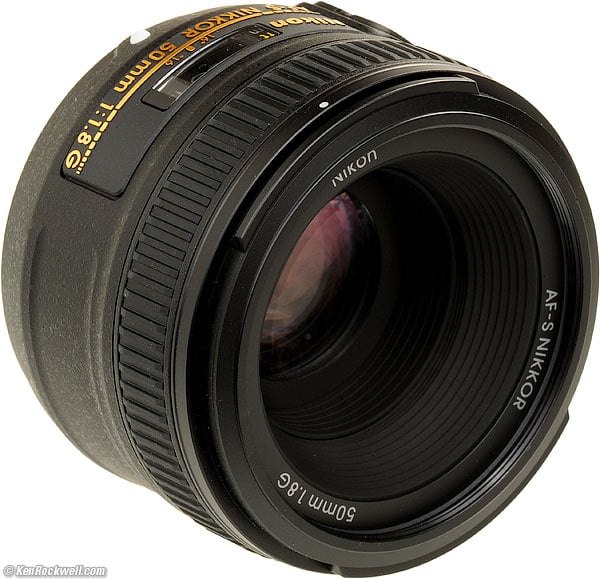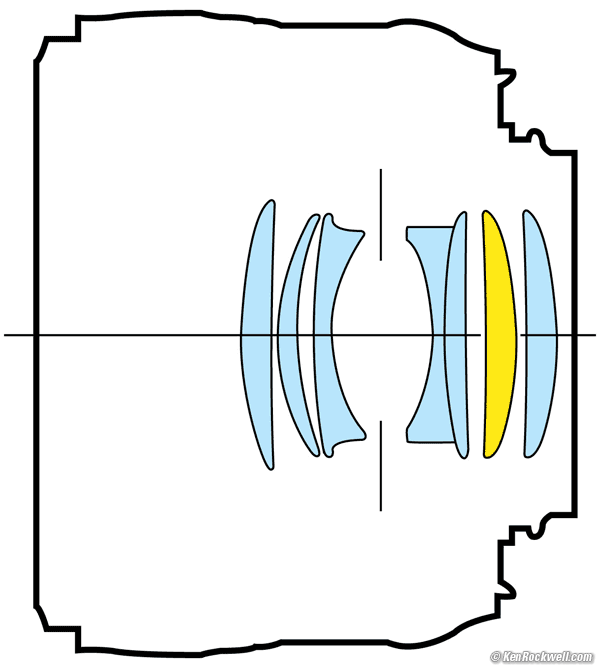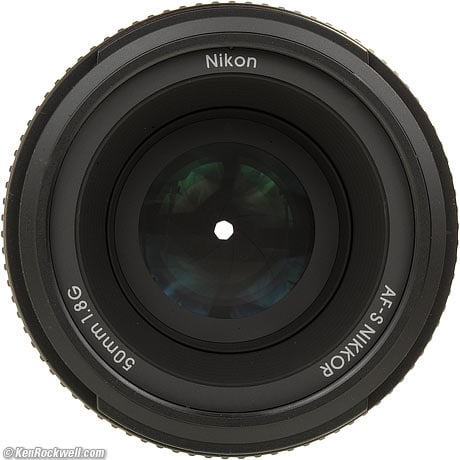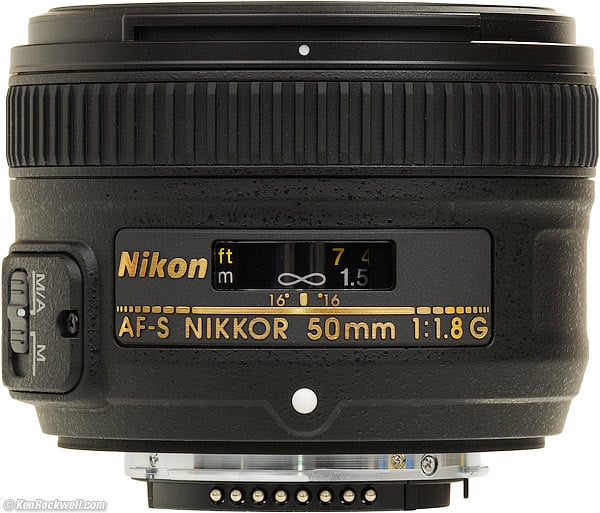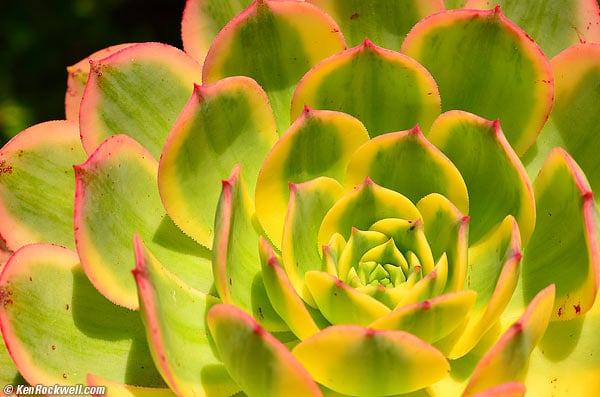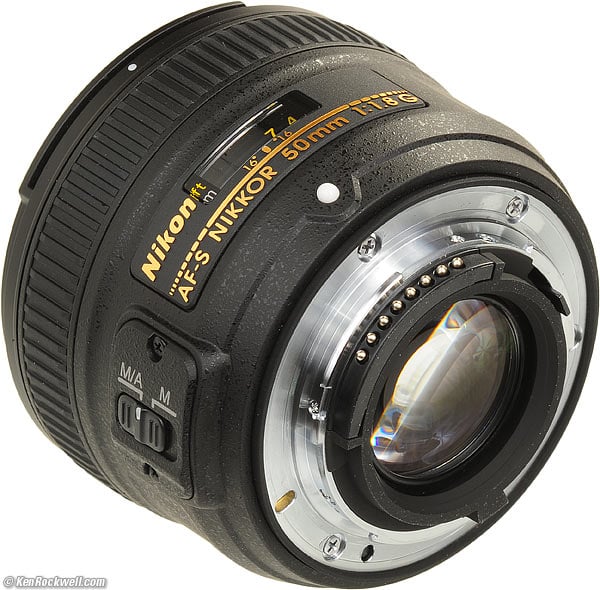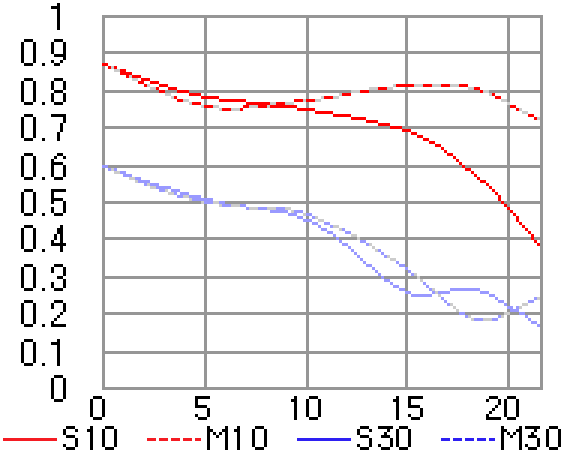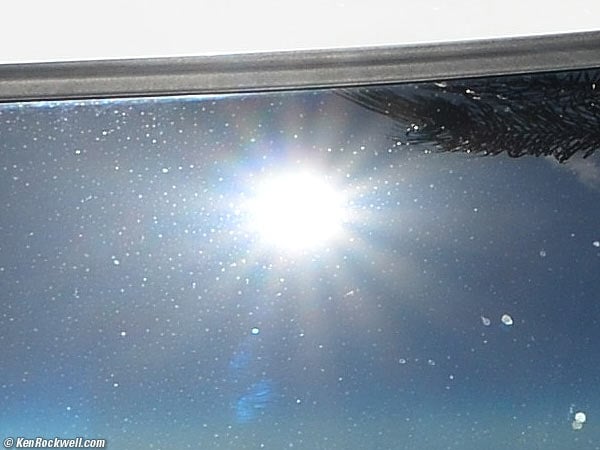Home Donate New Search Gallery Reviews How-To Books Links Workshops About Contact
Nikon 50mm f/1.8 G
FX, DX and 35mm coverage (2011-)
© 2014 KenRockwell.com. All rights reserved.
Intro Specifications Performance Usage Compared Recommendations
Nikon AF-S 50mm f/1.8 G. enlarge. (58mm filters, 6.6 oz./185g, 1.5'/0.45m close focus). The biggest source of support for this free website is when you use these links, especially this direct link to this lens at Adorama and at Amazon, when you get anything, regardless of the country in which you live. Thank you! Ken.
September 2014 Nikon Reviews Nikon Lens Reviews Other Reviews
NEW: Premium 50mm Lenses Compared 04 September 2014
Full-resolution 16MP DX sample image
See also:
Nikon 50mm f/1.8 AF-D (older version, 2002-)
Nikon 50mm f/1.8 AF (oldest AF version, 1986-2001)
Nikon 50mm f/1.4 G AF-S (f/1.4 version, 2008-)
Nikon 50mm f/1.4 AF-D (older version of f/1.4, 1986-)
Ideal for: Perfect for use on FX digital, DX digital and 35mm film. On DX cameras, the viewfinder is usually at close to 100% magnification, making two-eyed shooting easy.
Not for: Rich people who just don't feel right unless they pay a lot of money for something, or people who need no distortion, for whom the Nikon 50mm f/1.8 AF-D has less distortion for half the price. Otherwise, everyone needs some sort of 50mm f/1.8 and not much more.
Introduction top
Intro Specifications Performance Usage Compared Recommendations
Compatibility Previous Versions
|
I personally suggest Adorama, Amazon, Ritz, B&H, Calumet and J&R. I can't vouch for ads below.
|
This Nikon 50mm f/1.8 G is Nikon's latest iteration of their classic 50mm f/1.8 lens, first introduced in 1978. This new version adds the first new optics since 1978, and updates the traditional screw-focus system of 2002's Nikon 50mm f/1.8 AF-D with a modern AF-S system. Therefore, this new lens allows instant manual-focus override simply by grabbing the focus ring at any time.
This is Nikon's first aspherical 50mm lens. Nikon's only other aspherical normal lens is the 58mm f/1.2 Noct-NIKKOR, which sells used for thousands of dollars.
This is the world's first 50mm f/1.8 that autofocuses on Nikon's cheapest DSLRs like the D3100 and D5100.
The previous 50mm f/1.8 lenses have always been stellar optical performers, as is this new lens. This new 50mm lens is among Nikon's sharpest, but so are most 50mm lenses from every maker.
Everyone needs a 50mm lens, and it's about the only lens you'll need. This 50mm f/1.8 G is super sharp, focuses perfectly, and has superb bokeh as well.
This 50mm f/1.8 G is one of Nikon's best lenses at any price, and also one of their least expensive.
Everything works perfectly on every digital Nikon, both FX and DX, and even on Nikon's cheapest digitals like the D40, D40x, D60, D3000, D3100, D5000 and D5100.
It's also perfect on decent or recent AF film cameras like the F6, F100, F5, N80 and N75. I tried it on my Nikon F4, and it works great, although there's no way to set a manual aperture as explained below.
The incompatibilities for older or cheaper film cameras are that:
1.) It won't autofocus with the cheapest new AF 35mm cameras like the N55, but if you focus manually, everything else works great. Even if you lose autofocus, these cameras have in-finder focus confirmation dots to help you.
2.) Late 1980s ~ early 1990s AF cameras like the N90s, N70 and F4 will focus just fine and you'll have Program and Shutter-priority modes, but lose Manual and Aperture-priority since you have no way to set the aperture on the camera or on the lens.
3.) You're really pushing it with the oldest AF cameras like the N2020, N6006 and N8008. You'll have no AF and very confused exposure modes. Manual focus is fine, along with electronic focus indications.
4.) Since it has no aperture ring, it's just about useless with manual focus film cameras. It will shoot every shot at its minimum aperture.
See Nikon Lens Compatibility for details with your camera. Read down the "AF-S, AF-I" and "G" columns for this lens. You'll get the least of all the features displayed in all columns, since "G" (gelding) is a deliberate handicap which removes features.
These all use the same glass as each other, but in different mounts. This G lens is the first new optical design since 1978.
The popular 50mm f/1.8 AF-D remains in production, as it works fine on 35mm manual-focus Nikons, while this new G lens does not.
Nikon 50mm f/1.8 AF-D (2002-)
Nikon 50mm f/1.8 AF (1986-2001)
Nikon 50mm f/1.8 Series E (1979-1985)
Nikon 50mm f/1.8 AI (1978-1982)
Nikon 50mm f/1.8 G AF-S. enlarge.
Specifications top
Intro Specifications Performance Usage Compared Recommendations
Name top
Nikon calls this the Nikon AF-S Nikkor 50mm f/1.8G.
NIKKOR: Nikon's brand name for their lenses.
AF-S and SWM: Silent Wave Autofocus Motor.
G: Gelded for cost-reduction and removing compatibility with older cameras.
∅58: 58mm filter thread.
Aspherical: Specially shaped glass to give even sharper pictures, especially at f/1.8.
Optics top
Internal diagram, Nikon 50mm f/1.8G. enlarge. (original graphic by Trip Ulvila for KenRockwell.com)
7 elements in 6 groups.
One aspherical element, shown in yellow.
It's multicoated, which Nikon calls Nikon Integrated Coating.
This is Nikon's first new optical design for a 50mm f/1.8 lens since 1978. Previous lenses used 6 spherical elements.
Diaphragm top
Front, Nikon AF-S 50mm f/1.8 G at f/16. enlarge.
7 rounded blades.
Stops down to f/16 (not f/22 as does every other Nikon 50mm f/1.8).
Coverage top
Focal Length top
50mm.
When used on a DX camera, it gives angles of view similar to what a 75mm lens gives when used on an FX or 35mm camera.
Angle of View top
47° on FX and 35mm.
(31.5° on small-format DX.)
Close Focus top
1.5 feet (0.45m).
Maximum Reproduction Ratio top
1:6.7.
Filter Thread top
58mm, plastic.
Does not move or rotate.
Hard Infinity Focus Stop? top
No.
You have to let the AF system focus at infinity.
Focus Scale top
Yes, but very basic.
Depth-of-Field Scale top
Not really, just two little tits for f/16.
Infra-Red Focus Index top
No.
Aperture Ring top
No.
Bayonet Mount top
Metal.
Rear Weather Seal top
Yes.
Size top
Nikon specifies 2.1" (52.5mm) extension from flange by 2.8" (72mm) diameter.
Weight top
6.523 oz. (184.9g), measured.
Nikon specifies 6.6 oz. (185g).
Hood top
The HB-47 plastic bayonet hood is included.
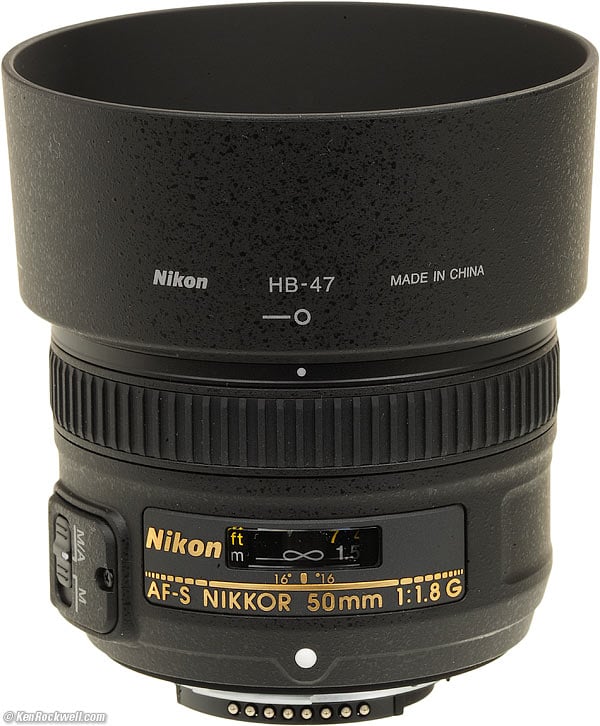
Nikon 50/1.8 G and HB-47 plastic hood.
Sack top
CL-1013 bag, included.
A used sock protects better and is easier to use.
Box and Packaging top
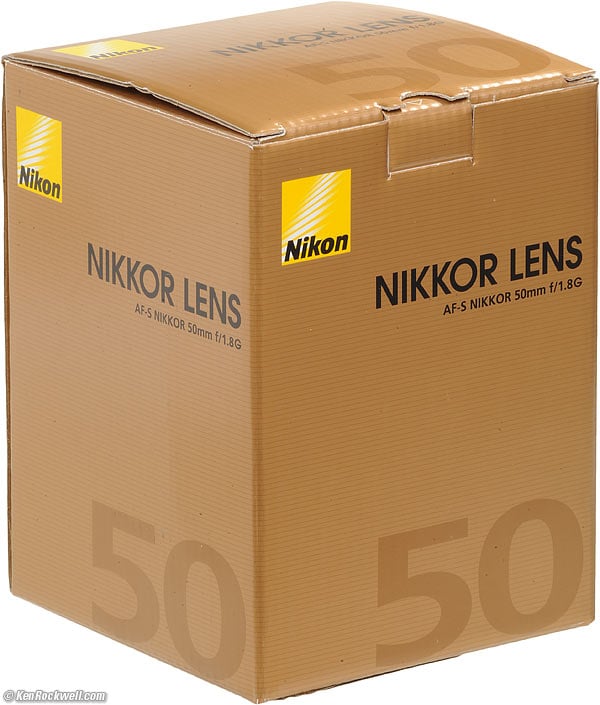
Nikon 50/1.8 G box.
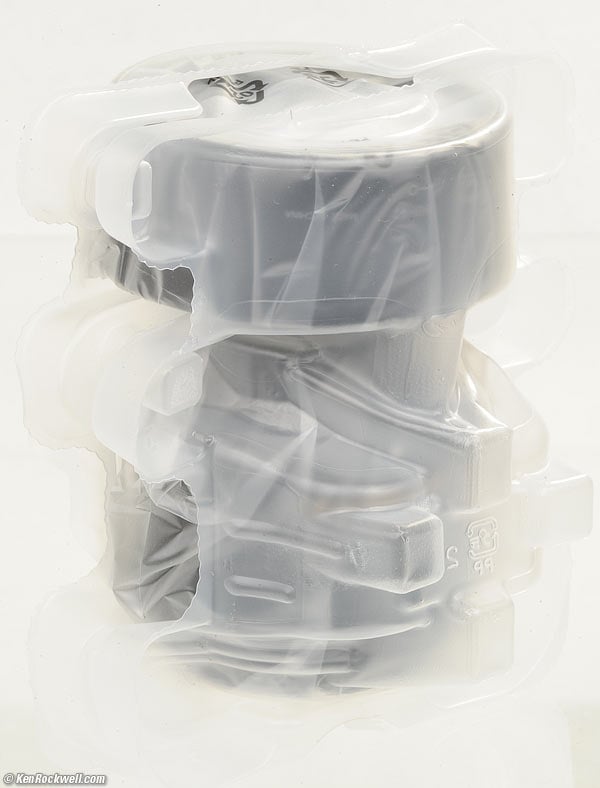
Frozen smoke inner buffer.
The lens and hood are held separately inside a soft plastic former, each in its own plastic bag.
Included top
LC-58 snap-on front lens cap.
LF-4 rear cap.
HB-47 hood.
CL-1013 bag.
Quality top
Made in the People's Republic of China.
Front and rear caps each made in Thailand.
Introduced top
Listed on Nikon, Japan's website as a new product 13 April 2011, then curiously withdrawn.
Reappeared on Nikon, Japan's website again on 27 April 2011, along with a formal press release.
Available since top
June 2011.
Nikon Product Number top
2199.
Price, USA top
$217, September 2014.
$220, April-June 2011.
Performance top
Intro Specifications Performance Usage Compared Recommendations
Overall Autofocus Bokeh Color Coma Distortion
Ergonomics Eyeblow Falloff Filters Flare and Ghosts
Focus Breathing Hood Lateral Color Fringes Macro
Mechanics Sharpness Spherochromatism Sunstars Survivability
Overall performance top
The Nikon 50mm f/1.8 G AF-S is solid, inexpensive and well made (by current standards that accept made-in-China plastic), and it's a great performer. If you don't already have something similar, everyone deserves one of these.
Autofocus performance top
Overall
Autofocus is fast, easy and accurate. I wish everything worked this well.
AF Speed
AF is as fast as every other Nikon AF-S lens.
AF Accuracy
On my D7000, AF was always right-on, especially at f/1.8 where it matters.
Manual Focus
Manual focus works great; just grab the ring at any time.
The rubber ring is grippy so it can be moved with a single fingertip, although the mechanics are stiffer than real Nikon Manual-Focus lenses.
M/A - M Switch
Nikon goofed. This switch is supposed to be labeled "A - M."
The "M/A" position means autofocus. It's called "M/A" because you also can focus manually simply by grabbing the focus ring in this position.
The "M/A" position means autofocus. It's called "M/A" because back in the old days, when Nikon had almost caught up to Canon who had been doing this for ten years before, Nikon was trying to show off that you could focus manually while in the AF position.
Paint over the extra M if you're easily confused.
Bokeh performance top
Bokeh, the character of out of focus backgrounds, not simply how far out of focus they are, is great. Out-of-focus backgrounds are always soft and never distract.
Ryan and Dada in Del Mar. (Nikon D7000, built-in flash, Nikon 50mm f/1.8 G, Program auto, auto white balance and auto ISO chose 1/250 at f/5 at ISO 100.) Full-image at full resolution.
At f/1.8, it's also smooth.
Color Rendition performance top
I can't see any difference from any of my other modern NIKKOR lenses.
Coma performance top
Any coma is minimal at worst, better than the earlier 50mm f/1.8 lenses. I expected this from the aspherical design.
Coma (saggital coma flare) often causes weird smeared blobs to appear around bright points of light in the corners of fast or wide lenses at large apertures. In lenses that have it, coma goes away as stopped down.
Distortion performance top
This new 50/1.8 G has a moderate amount of barrel distortion, while all the other the 50mm f/1.8 lenses, especially the 50/1.8 AF-D which sells today for half the price, has none. You'll never notice it, unless you like to shoot brick walls.
If brick walls are your thing, this Nikon 50mm f/1.8 sadly has far more distortion than any other Nikon 50mm f/1.8 or f/2 lens, ever. Even Nikon's very first 50mm f/2 lens of 1946 has less distortion than this new lens!
How could Nikon screw up such a simple and basic lens? Easy: by following the "two steps forward, one step back" Japanese strategic marketing plan. This means adding a few showy new features, but quietly taking away something we really need. What we need is then added in the next version, as if it's something new and wonderful again.
The 50/1.8 G's distortion can be largely corrected by plugging these figures into Photoshop's lens distortion filter, however the distortion is slightly complex on FX, so it never corrects completely with simple tools like Photoshop. These aren't facts or specifications, they are the results of my research that requires hours of photography and calculations on the resulting data.
FX and Film |
||
∞ |
+1.7 |
+0.5 |
10' (3m) |
+1.7 |
+0.8 |
© 2011 KenRockwell.com. All rights reserved.
Ergonomics (handling and ease-of-use) performance top
Nikon 50mm f/1.8 G AF-S. enlarge.
Ergonomics are just about perfect. They are the primary reason to pay twice as much as the perfectly good 50mm f/1.8 AF-D.
This is a tough lens, and all one needs to do to focus manually is grab the ring. With a filter on the front, it's reasonably well sealed against physical damage and dust, unlike zooms or the 50mm f/1.8 AF-D.
Eyeblow performance top
I can't detect any air coming out of my viewfinder as focused. The internal optics move as a unit inside the outer barrel.
Falloff (darkened corners) performance top
Falloff on FX is typical: some of the usual wide open, and goes away stopped down. It's the same as the Nikon 50mm f/1.8 AF-D.
It won't be an issue at all on DX (see crop factor).
I've exaggerated this by shooting a gray field and placing these on a gray background.
Nikon 50mm f/1.8 G AF-S falloff on FX and film at infinity, no correction.
© 2011 KenRockwell.com. All rights reserved. |
Filters, use with performance top
There is no problem with vignetting, even with combinations of thick filters.
58mm is a generous filter size, so it never gets in the way.
The filter ring does not move; the glass moves around inside the barrel.
Flare and Ghosts performance top
I couldn't get any ghosts or flare, even looking straight into the sun, even in the shadows:
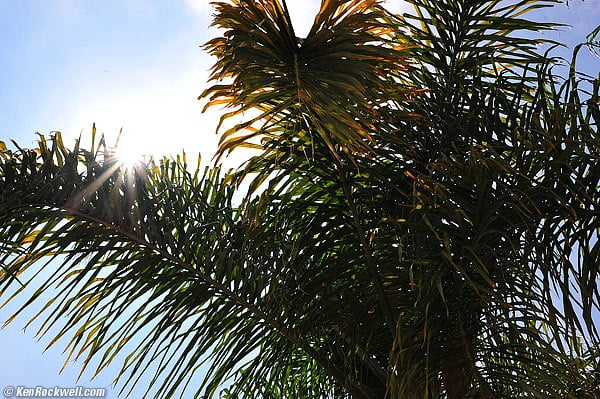
Direct disc of the California noontime sun. Nikon 50mm f/1.8 G AF-S at f/11, full FX image.
Let's do something completely unreasonable, and add two more stops of exposure to see into the backlit palm. Remember, that's the direct sun is beating directly down on us so brightly that I couldn't actually look at this as I shot it. No one would do this; you'd be exposing to show the sun, not the shadow:
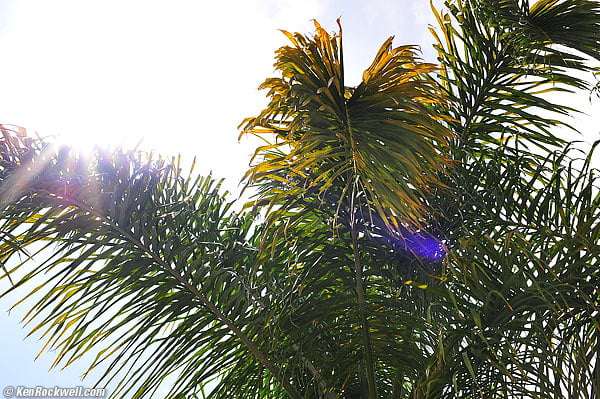
Direct disc of the California noontime sun. Nikon 50mm f/1.8 G AF-S at f/11, full FX image.
Even without a hood, the front glass is deeply recessed in the barrel, so I doubt there will ever be any problem with flare or ghosts.
Focus Breathing performance top
Of interest mostly to cinematographers focusing back and forth between two subjects, the image from the Nikon 50mm f/1.8 G grows as focused more closely.
This is as expected from a unit-focusing lens: the entire optical cell moves in and out as one unit as focused.
Hood performance top
The plastic hood is included. It works fine.
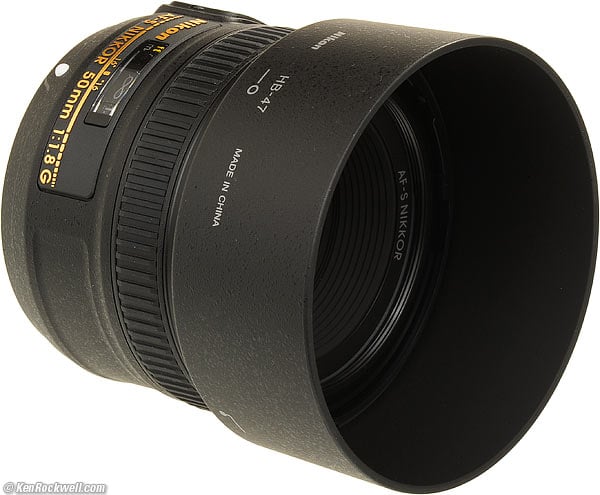
Nikon 50/1.8 G and HB-47 plastic hood.
Lateral Color Fringes performance top
There are no lateral color fringes on the D3 or D7000, which corrects them automatically.
There is a bit of spherochromatism, which is a different aberration.
Macro performance top
Close-focus reproduction ratio is the same as most fixed Nikon lenses.
Self Realization Fellowship. bigger.
Full DX image at close-focus distance. (D7000, f/7.1 at 1/200, ISO 100)
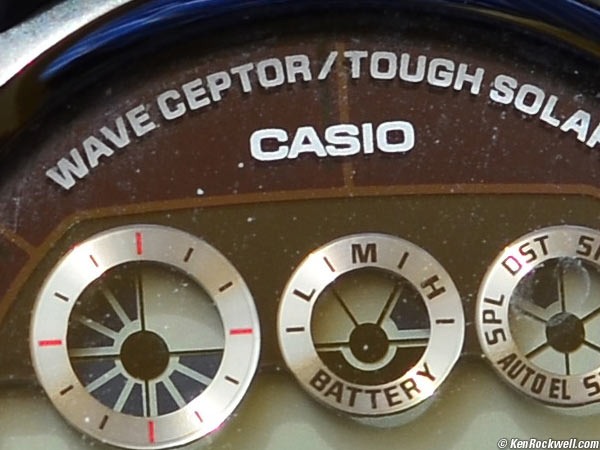
Crop from above at 100%. If the entire image was printed at this magnification, it would be 50 x 35 inches (1.5 x 1 meter).
Mechanics and Construction performance top
Nikon 50mm f/1.8 G AF-S. enlarge.
The Nikon 50mm f/1.8 G is typical of Nikon's current amateur lenses: metal mount, glass glass, and plastic everything else.
For reasons unknown, even though the mount looks the same as my other NIKKORs, the mounting and unmounting feel is a little rougher than my older, well-worn-in pro lenses.
Filter Threads
Plastic.
Hood
Plastic bayonet.
Hood Mount
Plastic.
Barrel Exterior
Plastic.
Focus Ring
Plastic; rubber covered.
Focus Helicoids
Feel like plastic.
Depth-of-Field Scale
None, unless you consider two little tits right next to each other for f/16 as something useful.
Aperture Ring
None.
Mount
Dull-chromed brass.
Markings
Paint.
Mounting Index Dot
White plastic ball.
Identity Plate
Plastic (lettering looks like debossed metal, but it is just plated plastic).
Serial Number
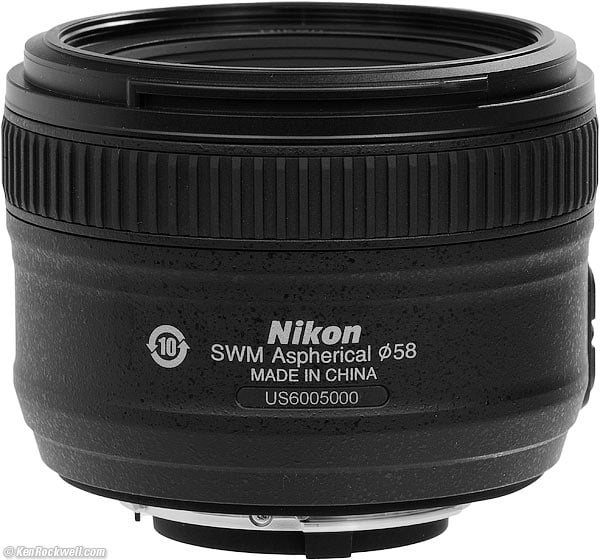
Bottom, Nikon 50mm f/1.8 G AF-S.
The serial number is on a sticker glued into a recess in the bottom of the barrel.
US Model Signified by
"US" prefix to serial number.
Ass-Gasket (rain seal at mount)
Yes.
Noises When Shaken
Mild clunking.
Quality
MADE IN CHINA.
Sharpness performance top
Warning 1: Image sharpness depends more on you than your lens.
Warning 2: Lens sharpness doesn't mean much to good photographers.
With these caveats, the Nikon 50mm f/1.8 G is among Nikon's sharpest lenses.
As expected for the latest aspherical designs at any price, the 50/1/8 G is sharp at every aperture.
At f/1.8, it's only slightly less sharp in the corners of FX or DX, and sharpens right up as soon as stopped down a couple of stops.
As shown above under Bokeh, it can be too sharp sometimes.
Here are Nikon's claimed MTF curves:
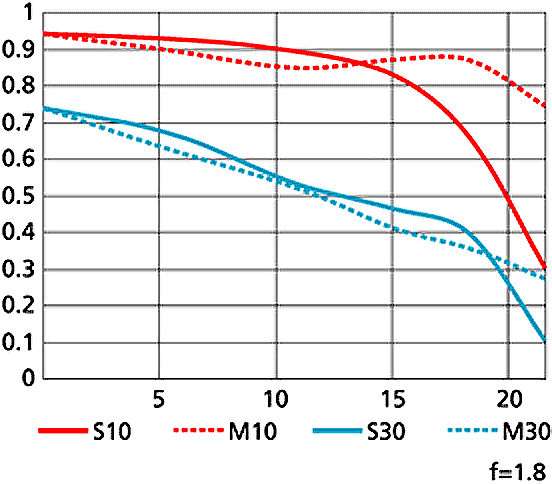
Nikon's MTF Curve, 50/1.8 G.
For comparison, here's the same for the 50/1.8 AF-D at f/1.8:
Nikon's MTF Curve, 50/1.8 AF-D.
Spherochromatism performance top
The 50mm f/1.8 G has a slight bit of spherochromatism. Out-of-focus foreground highlights can sometimes have a bit of a magenta fringe around them, and out-of-focus background highlights can sometimes have a bit of green around them. This helps bokeh most of the time.
Spherochromatism is sometimes mistakenly called "color bokeh" by laymen, and is common in fast lenses.
Sunstars performance top
Sunstar, car window reflection. Nikon 50mm f/1.8 G AF-S at f/9, highly cropped from center of 100% 16MP DX image.
With its rounded 7-bladed diaphragm, the 50/1.8 G tends to make soft, subtle 14-pointed sunstars on bright points of light, if any at all.
The conventional 7-bladed diaphragm of the Nikon 50mm f/1.8 AF-D gives much sharper sunstars.
Survivability performance top
The Nikon 50/1.8 G is pretty tough because all its optics and delicate parts are protected within the outer barrel.
Use a filter, and nothing moves externally. The filter protects against airborne threats, and the delicate internals are completely protected inside the outer barrel.
The older 50mm lenses have fronts that move in and out; this lens and the newest 50/1.4 G don't.
Usage top
Intro Specifications Performance Usage Compared Recommendations
Leave the M/A — M switch in M/A. In M/A, you get autofocus, and if you want manual focus, just grab the ring at any time.
The M position disables autofocus; giving manual-only focus. I only use the M position as a hard focus lock; I grab the ring for instant manual focus.
I'd leave either a 58mm Nikon Clear (NC - UV) filter, or a 58mm Hoya Super HMC UV on the lens at all times.
If I was working in nasty, dirty areas, I'd forget the cap, and use an uncoated 58mm Tiffen UV filter instead. Uncoated filters are much easier to clean, but more prone to ghosting.
For color slides like Velvia 50 shot outdoors, I use a 58mm Hoya HMC 81A.
For B&W film outdoors, I'd use a 58mm Hoya HMC K2 Yellow or 58mm Hoya HMC Orange.
Compared top
Intro Specifications Performance Usage Compared Recommendations
NEW: Premium 50mm Lenses Compared 04 September 2014
Distortion is much worse than any other Nikon 50mm f/2 or f/1.8 lens.
I prefer the conventional straight-bladed diaphragms of older lenses that make much better sunstars than this new lens. This lens makes wimpy sunstars, if any at all.
The earlier Nikon 50mm f/1.8 AF-D costs about half as much, has none of the distortion, focuses just as close and fast, is just as super-sharp at normal apertures, stops down to f/22 instead of being limited to f/16, and weighs much less. Although the older 50/1.8 isn't quite as sharp in the corners at f/1.8 (who cares), it is just as sharp in the center. The biggest difference is on which cameras each autofocuses — or not (see Nikon Lens Compatibility), and the huge ergonomic advantage to instant manual-focus override on this new G lens. This new G lens is also tougher when hit from the front, with or without its hood.
Anni |
Filter |
Weight |
Diaphragm |
Distortion |
Price, 6/2011 |
|
(3m, FX) |
||||||
2011- |
58mm |
185g plastic |
7 rounded |
+1.7 |
||
2002- |
52mm |
157g plastic |
7 |
0 |
||
1986-2002 |
52mm |
155g plastic |
7 |
0 |
||
2008- |
58mm |
278g plastic |
9 rounded |
+2.0 |
||
1986- |
52mm |
229g plastic |
7 |
+1.4 |
||
1978-1985 |
52mm |
135-155g hybrid |
7 |
0 |
||
1978-1982 |
52mm |
220-145g metal |
7 |
0 |
||
1974- |
52mm |
354g metal |
9 |
|||
1950-1962 |
43mm |
150g metal |
12 |
-1.0 |
||
1946-1962 |
40.5mm |
134g metal |
10 |
-1.2 |
Recommendations top
Intro Specifications Performance Usage Compared Recommendations
For use on Nikon's cheapest DSLRs like the D40, D40x, D60, D3000, D3100, D5000 and D5100, the Nikon 50mm f/1.8 AF-S G is the best 50mm lens one can get, next to the 50mm f/1.4 AF-S. No other Nikon 50mm lens will autofocus on these cameras.
For all other Nikon DSLRs and Nikon AF cameras made since about 1990, the Nikon 50mm f/1.8 AF-D does the same thing for half the price, however this new "G" lens offers a much tougher mechanical design and significantly better ergonomics because one can just grab the manual focus ring at any time for instant manual focus override.
On AF cameras older than about 1990 and on manual-focus 35mm cameras, this G lens won't work at all. Get the Nikon 50mm f/1.8 AF-D instead. (Details at Nikon Lens Compatibility.)
This 50mm f/1.8 G lens is super-duper sharp, but sadly has some visible barrel distortion on FX and 35mm. If this is important to you, use the Nikon 50mm f/1.8 AF-D.
I see no real need for the 50/1.4 G lens, since I prefer Professional exposure mode (P), and I prefer in low light to shoot at f/1.8 instead of f/1.4, which is what happens with either of these lenses in Professional mode as it gets dark. If you already own the 50/1.4 G, you may ignore this lens, since they have pretty much the same optical performance and size. As always, Nikon introduced the twice as expensive f/1.4 three years before this f/1.8 so that folks like me would buy the more expensive version instead; but today, get the f/1.8 for digital. Save the super-hot f/1.4 for 35mm shooting.
If you've found this research helpful, this website's biggest source of support is when you use these links, especially this direct link to this lens at Adorama and at Amazon, when you get anything, regardless of the country in which you live. Thank you! Ken.
More Information
Help me help you top
I support my growing family through this website, as crazy as it might seem.
The biggest help is when you use any of these links when you get anything. It costs you nothing, and is this site's, and thus my family's, biggest source of support. These places always have the best prices and service, which is why I've used them since before this website existed. I recommend them all personally.
If you find this page as helpful as a book you might have had to buy or a workshop you may have had to take, feel free to help me continue helping everyone.
If you've gotten your gear through one of my links or helped otherwise, you're family. It's great people like you who allow me to keep adding to this site full-time. Thanks!
If you haven't helped yet, please do, and consider helping me with a gift of $5.00.
As this page is copyrighted and formally registered, it is unlawful to make copies, especially in the form of printouts for personal use. If you wish to make a printout for personal use, you are granted one-time permission only if you PayPal me $5.00 per printout or part thereof. Thank you!
Thanks for reading!
Mr. & Mrs. Ken Rockwell, Ryan and Katie.
Home Donate New Search Gallery Reviews How-To Books Links Workshops About Contact





